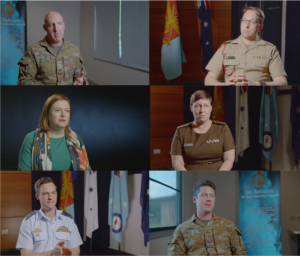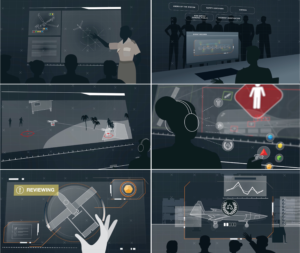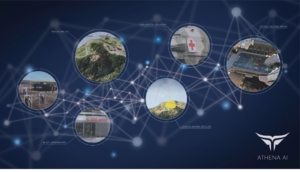High altitude technologies taking off in Queensland!
/in Blog, News/by TASOn Friday 22 July in a large exhibition hall in Brisbane, an innovative Queensland company, DanField Stratoship undertook a demonstration inflation of a stratospheric air ship.
The demonstration was organised by Trusted Autonomous Systems, a Defence Cooperative Research Centre in conjunction with the Royal Australian Air Force (RAAF) Air Warfare Centre (AWC), and as part of the groups involvement in the High-Altitude Pseudo Satellite (HAPS) Challenge.
The HAPS Challenge is exploring high altitude technologies including balloons that provide a range of lower-cost mechanisms to deploy payloads to areas of interest. Functions can include pseudo-satellite and persistent surveillance where reliable station-keeping and path-prediction functions are established. These technologies can provide lower cost, rapidly deployable capabilities for communications and surveillance tasks including bushfire early warning. HAPS Challenge management incorporates (Sir Lawrence Wackett Defence & Aerospace Centre – RMIT, SmartSat CRC, Trusted Autonomous Systems and RAAF Air Warfare Centre) supported by the Bureau of Meteorology.
The inflation demonstrates the technical status of the Stream 1 of the Challenge (Automated of Autonomous HAPS Platform Station Keeping & Constellation Maintenance) under the Power and Control in the Stratosphere (PACITS) project. This is currently in Phase 3, Prototype Development & Demonstration. PACITS is led by Danfield Stratoship and supported by a team The Stratoship Group including its sibling company Skysite, SuperSky Engineering, SmartSat Services and the Australian National University.
Ultimately, the conclusion on the Challenge will see a practical demonstration of the technology, deployed to the Stratosphere with regulatory approval processes underway.

Stratoship Group members at the remote pilot station.
TAS awards Defence contributors to autonomy projects at ADSTAR 2022
/in Blog, News/by adminOutstanding contributions to industry-led innovation and trust frameworks by Defence personnel have been recognised by Trusted Autonomous Systems (TAS) with six recipients receiving a 2022 Autonomy Accelerator Award.
The six recipients were individuals and teams who were nominated by TAS industry participants and TAS Project and Activity leads.
The Autonomy Accelerator Award recognises the significant contribution made by the recipient to the advancement of autonomous systems in Australia. Recipients have gone above and beyond to ensure delivery, displayed integrity, and been strongly committed to achieving shared goals.
Award recipients delivered on the TAS commitment to game-changing capability impact through industry projects and policy progress, which will ease pathways to deployment of trusted autonomous systems.
The recipients of the 2022 Autonomy Accelerator Awards are list below.
Robert Bolia
Program Leader LVC, Air & Space Program, DSTG
Robert serves as Program Leader LVC at DSTG, the latest in a series of leadership positions he has held there. Before migrating to Australia, he spent his career working for the US DoD, culminating in eight years at the Office of Naval Research Global, based in Japan and Chile. Before that he led the Asia-Pacific section at AFRL HQ, where he was charged with building and executing AFRL’s international engagement strategy for the Asia-Pacific region, and for developing collaborative research programs between AFRL and defence laboratories in the region. Prior to that he was a human factors scientist in the AFRL Human Effectiveness Directorate.
Robert was nominated for his science leadership and vision for building industry-led trusted autonomous systems as well as his commitment to building ethical frameworks suitable for Defence contexts of use. Robert has been a champion of TAS since inception in 2018, working collaboratively across organisations and stakeholder groups to increase sovereign capability for Australia. Robert’s commitment is evidenced in his co-authorship of ‘A Method for Ethical AI in Defence’ report by DSTG, RAAF and TAS leading to national and international policy impact including NATO and the TTCP AI Strategic Challenge.
Jared Freundt, George Katselis, Kris Allpress, Samuel Weckert, and Ian Lochert
Advanced Warhead Technologies Group, Weapons and Combat Systems Division, DSTG
Jared Freundt has over 20 years’ Defence Science and Technology experience focussed on characterising the performance of weapon system in support of Australian Defence Force requirements. Jared is a subject matter expert in high-speed photo instrumentation capability and has developed novel imaging techniques and analysis methods. In addition, he has developed a wide range of skills including; finite element analysis, explosive ordnance handling and safety and trial management. Due to his significant experience, he is currently working with the DSTG Trials Authority to ensure DSTG is well positioned for delivery of more complex trials into the future and to ensure they are managed consistently, safely and efficiently.
Jared Freundt and his team (George Katselis, Benjamin Hall, George Katselis, Kris Allpress, Samuel Wechert, Ian Lochert and others) in WSD were nominated for their exemplary collaboration with Skyborne Technologies on the Gannet Glide Drone program.
They produced a number of experimental warheads, which were tested successfully both in a standalone and integrated capacity. The collaboration resulted in an impressive demonstration at Port Wakefield in South Australia. Their efforts enabled a very successful outcome on all fronts.

Jared Freundt and his team were nominated for their exemplary collaboration with Skyborne Technologies.
Michael Gan
Royal Australian Airforce; Artificial Intelligence Lead, Jericho Disruptive Innovation
Wing Commander Michael Gan commenced in his role as Deputy-Director Artificial Intelligence at Air Force’s Jericho Disruptive Innovation in September 2018. His previous experience in air mobility operations (particularly in humanitarian aid and disaster relief) as well as in critical thinking and ethics in professional military education has strongly influenced his approach to the development or Artificial Intelligence in the Royal Australian Air Force. His main focus has been on developing and exploring the AI foundations of education, ethics and assurance, while exploring Defence applications for computer vision and imagery analysis, natural language processing and AI/Data analytic decision support tools.
Michael Gan was nominated as a champion of industry-led innovation and his sustained commitment to building trusted sovereign capability in robotics, autonomous systems, and artificial intelligence. Michael ensures alignment of industry-led projects to Defence values in his ethical, legal and assurance of autonomy frameworks and tools exemplified in his co-authorship of ‘A Method for Ethical AI in Defence’ DSTG Technical Report by DSTG, RAAF and TAS leading to national and international policy impact including NATO and the TTCP AI Strategic Challenge.
Robert Morris
Aerospace Division, DSTG
SQNLDR Morris has extensive RAAF Aircrew experience, primarily as an Airborne Electronics Officer and sensor employment specialist on P3-Orions, amassing around 7,500hrs. He also has UAS expertise from his involvement in the 2006, DSTG NW Shelf UAS trial. In 2010, he was selected as the Commanding Officer for the Heron UAS deployment to Afghanistan, (logging 400hrs). He has a wealth of experience in LOAC, Joint Fires, and Targeting from his time the Air and Space Operations Centre and HQJOC. SQNLDR Morris has been an Air Liaison Officer at DSTG since 2019 and with Human Factors group, in Aerospace Division since 2021.
The nomination recognised Robert (Bob) Morris for his excellent work in leading the HF assessments of Athena AI. From the time Bob came onboard, he worked directly with the engineering team to identify improvements to the capability, the training program and how evaluations would be conducted. Bob bought operational skills from decades of UAS experience in both theatre and T&E. He also supported liaison with RAAF and initial datasets for evaluation and integration. He worked directly with our engineering team to address roadblocks as they came up.
Upon conclusion of the project Bob Morris had conducted training and evaluation of Australia’s first AI enabled sensor to effector capability with 2 military units being 2SECFOR and 20STA, both of which were able to proficiently use the software within one day of training.
Karl Sammut
Professor, College of Science and Engineering, Flinders University
Professor Karl Sammut is a Co-Director of the Centre for Defence Engineering at Flinders University. Karl received his Ph.D from Nottingham University in 1992 before taking up positions at the Politecnico di Milano, followed by Loughborough University and then at Flinders University. Between 2019 and 2022, he held a part-time position as a Senior Principal Scientist with DSTG. Karl has over twenty years experience in maritime autonomy research for the development of uncrewed surface and underwater vehicles and has worked in collaboration with Trusted Autonomous Systems, DSTG, Thales, Boeing Australia, Lockheed Martin Australia, Naval Group and Fincantieri.
Karl was a key founding member of the team, and in concert with Thales and USYD helped put together the original proposal with Thales for the MCM in a day project. Karl and the Flinders team have been instrumental in driving the project forward from systems, software and hardware development perspective.
Karl is a driven and highly dependable member of the ‘MCM in a Day’ project. He has consistently supported and motivated the development of key software and hardware resources, despite a number of challenges. In doing so, he has enabled the progression of many key integration activities. He has regularly contributed solutions to numerous technical and administrative challenges throughout the duration of the project and has offered important insights and ideas that have notably furthered the project’s development. Karl’s efforts have demonstrably progressed project development, both within his immediate team at Flinders University and the project team as a whole.
Karl and Flinders team attendance at PAC was a great example of the commitment to project success that Karl fosters in the Flinders team, driving the Crawler and associated kit across from SA for the event in Sydney to ensure the teams would maximise their time to work on the equipment. Karl’s attitude and commitment influences the whole TAS MCM in a day project team in a hugely positive way.
Rafał Sienicki, Research Specialist
Information Sciences, Defence Science and Technology Group
Rafał (Ralph) joined DSTG in 2005. He has provided research, systems engineering and project management contributions to Defence projects in the areas of electronic warfare, radar and communication systems, distributed systems, and modelling, simulation, and experimentation. He is currently pursuing a PhD with the University of Sydney on deep learning approaches for spatial-temporal characterisation and prediction of the electromagnetic environment.
Ralph Sienicki has provided invaluable insights on the electromagnetic operating environment its characterization and effects, identified relevant research problems and applied creative solutions. Ralph has corralled DSTG effort toward Distributed aUtonomous Spectrum Management (DUST) milestones and goals, written high quality technical investigation reports, contributed constructively to DUST project reports and whilst the DSTG partner point of contact provided an exemplar of PM partner reports.
Ralph has facilitated productive exchanges and negotiations between DUST partners to bring project outcomes. Most recently Ralph has commenced a PhD aligned to the DUST project under the supervision of the DUST UoS partner.
About Trusted Autonomous Systems
Trusted Autonomous Systems (TAS) is Australia’s first Defence Cooperative Research Centre uniquely equipped to deliver research into world-leading autonomous and robotic technologies to enable trusted and effective cooperation between humans and machines. Funded by the Commonwealth via the Next Generation Technology Fund (NGTF) and the Queensland State Government, TAS aims to improve the competitiveness, productivity, and sustainability of Australian industry through industry-led projects with real translation opportunities to move technology rapidly from universities into industry and ultimately into leading edge capability for the Australian Defence Force. Projects are supported by ‘common-good’ activities in ethics, law and assurance of autonomy accelerating the operationalisation of capabilities. TAS is developing the capacity of Australia’s defence industry to acquire, deploy and sustain the most advanced autonomous and robotic technologies.
New videos released in ‘A Method for Ethical AI in Defence’ series
/in Blog, News/by admin
In a newly released series of videos on ethical AI, Trusted Autonomous Systems explores responsibility, governance, trust, law, and traceability for robotics, autonomous systems, and artificial intelligence.
These videos were produced by Trusted Autonomous Systems for the Centre for Defence Leadership & Ethics (CDLE) at the Australian Defence College.
The videos feature Chief Defence Science Prof Tanya Monro, ADF personnel, and representatives from Defence industries.
They explore topics of responsibility, governance, trust, law and traceability using a hypothetical science fiction scenario Striking Blind written by Australian Defence College Perry Group students in 2021. In the Striking Blind story, an Australian autonomy platform is deployed in a future operation with a fictional AI called ‘Mandela’.
The videos explore ethical and legal factors associated with this scenario. They highlight the need for maintaining robust oversight so that the ADF can benefit from AI and autonomous systems while addressing their complex challenges.
Designed for the full Defence learning continuum, the videos are based on the framework and pragmatic tools described in the Defence Science technical report A Method in Ethical AI in Defence (2021).

Using the framework the videos cover:
- Introduction
- Responsibility – who is responsible for AI?
- Governance – how is AI controlled?
- Trust – how can AI be trusted?
- Law – how can AI be used lawfully?
- Traceability – How are the actions of AI recorded?
- Pragmatic tools
While the method does not represent the views of the Australian Government, it provides an evidence-based collaborative framework relevant to Australian Defence contexts of use as well as ethical and legal considerations aligned with international best practice.
These videos provide both an overview and an in-depth exploration of A Method for Ethical AI in Defence and can be used within professional military education and by external stakeholders of Defence, including academia.
How to use the videos
- Use animations as thought prompts within presentations and workshops on robotics, autonomous systems, and artificial intelligence amongst Defence stakeholders.
- Use longer videos in a ‘flipped classroom’ model of learning for professional education and training
- Use videos in multi-stakeholder meetings to establish a shared framework within which to identify ethical and legal risks for robotics, autonomous systems and artificial intelligence projects for Defence
- Use pragmatic tools videos to establish processes for the identification and management of ethical and legal risks on RAS-AI projects
How to cite the videos
Producer Tara Roberson (Trusted Autonomous Systems)
Creative Director Kate Devitt (Trusted Autonomous Systems)
Publisher Trusted Autonomous Systems
Production Company Explanimate
Sponsor Centre for Defence Leadership & Ethics, Australian Defence College
With thanks to all interviewees who appeared in the videos: Stephen Bornstein, Damian Copeland, Kate Devitt, Michael Gan, Chris Hall, Sean Hamilton, Lachlan Jones, Rebecca Marlow, Tanya Monro AC, Mick Ryan AM, Lauren Sanders, Jason Scholz & Dominic Tracey.
Cite as: Roberson, T. & Devitt, S.K. (2022). Ethics of Robotics, Autonomous Systems and Artificial Intelligence Videos for Defence. [14 Videos] Trusted Autonomous Systems. https://tasdcrc.com.au/ethical-ai-defence-videos/
The transcribed video series is available on the TAS website.





